Are you aware that a staggering 70% of the world’s water withdrawals are used for irrigation? Sadly, this is also where a majority of water waste occurs with approximately 60% of irrigation water lost due to evapotranspiration, land runoff, and inefficient usage methods.
With the growing global population and dwindling freshwater resources, urgent action is needed to improve how we collect, use, and store water on a global scale. This highlights the critical need to manage our resources in a smarter and more efficient manner, especially in emerging industries driven by the Internet of Things (IoT). Today, we will delve into the realm of smart irrigation and how it can play a significant role in alleviating the increasing water stress levels worldwide.
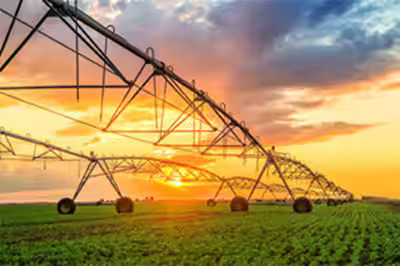
Hence, in this blog post, we will explore the key drivers shaping the smart irrigation market, identify the specific challenges that need to be addressed, and introduce the Radiocrafts Industrial IP Mesh solution (RIIM) as a promising solution for smart irrigation systems.
What are the Drivers in the Smart Irrigation Market?
The demand for eco-friendly systems and sustainable resource management has become a driving force in the smart irrigation market. There is a growing need to develop efficient and environmentally responsible architectures that minimize our ecological footprint. Additionally, there is a growing requirement to achieve these goals in a cost-effective manner, making the development of such infrastructure more accessible and feasible.
Smart irrigation has the remarkable ability to enable the development of irrigation systems and food production in previously inhospitable places, including desert landscapes. It may seem counterintuitive, but with smart irrigation, we can revolutionize how we view deserts – no longer as barren wastelands, but as fertile grounds for food production. This technology has the potential to transform arid landscapes into lush, food-producing paradises, allowing us to meet the increasing demand for food from a growing global population. Moreover, smart irrigation is particularly critical in impoverished regions, such as the Saharan region in Africa, where local food production can play a vital role in feeding the population and improving food security.

Nevertheless, the smart irrigation market faces certain constraints, such as limitations in accessing water, availability of arable land, and adequate labor to effectively manage the irrigation system.
What are the Specific Problems to be Solved in Smart Irrigation?
When it comes to building an efficient smart irrigation system, there are several wireless communication challenges that need to be addressed. Some of the key requirements include:
- Reliable Connectivity: Ensuring low packet loss and achieving a high packet received rate of 99.99% to ensure robust and dependable communication.
- Low Latency: Achieving low latency of around 10 ms for real-time applications where delays are unacceptable, while also accounting for applications that can tolerate slightly longer delays, such as in slow-moving processes like process monitoring and maintenance supervision.
- Sufficient Range and Coverage: Providing extensive range and coverage in large, semi-open rural environments to ensure seamless connectivity across the entire irrigation system.
- Two-Way Communication: Enabling two-way communication to not only collect data from sensors but also control devices like valves, allowing for remote operation and control of the irrigation system.
- Simple Implementation: Ensuring ease of implementation, particularly in harsh environments like deserts, where the system needs to withstand extreme conditions.
- High Reliability: Ensuring long battery lifetime for reliable operation and reducing the need for frequent battery replacements in remote locations.
- Simple Installation: Facilitating simple installation without the need for additional power cabling, making it easier to set up the system in various locations.
- Over-the-Air (OTA) Updates: Enabling OTA updates of firmware to allow for touchless updates, especially in remote and hard-to-reach locations where physical access may be challenging.
Addressing these wireless communication challenges is crucial for developing a robust and efficient smart irrigation system that can operate reliably in diverse environments and effectively optimize water usage for agricultural needs.

Radiocrafts Industrial IP Mesh solution (RIIM) as an Efficient Solution for Smart Irrigation Systems
Radiocrafts Industrial IP Mesh solution (RIIM) is a fully embedded Industrial IoT mesh module that comes with all the essential components for a complete wireless network, without any license fees or subscription costs. When you purchase the RIIM module, you get a ready-to-go solution for your smart irrigation system. What’s more, RIIM’s mesh network architecture enables it to be self-forming, self-healing, and self-optimizing, making installation and implementation of your smart irrigation system significantly simplified.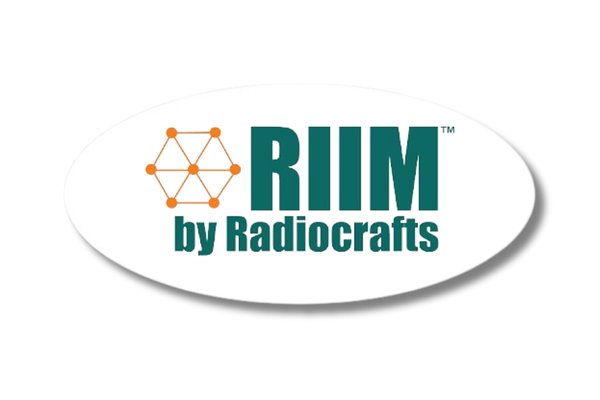
Radiocrafts Industrial IP Mesh solution (RIIM), offers an impressive coverage of approximately 80 x 80 km² in a semi-open rural environment. It supports up to 1400 meters between devices and can spread data across the network by relaying the data from device to device up to 28 times (28 mesh hops). RIIM can also accommodate up to 1000 nodes for a single border router (gateway), which helps reduce installation costs by requiring fewer gateways for large-scale deployments. Additionally, to cover an even larger area, you can easily add another border router.
One of the unique features of RIIM is its ICI (Intelligent C-Programmable I/O) framework, which ensures that the module’s behavior can be tailored to the specific requirements of each customer. The ICI application is always running on the module and allows for configuration of the radio network, hardware interfaces, and read/write operations to those interfaces. This means that you can directly interface with a wide range of sensors and actuators, such as soil moisture sensors, water valve controls, UV sensors, rain/freeze sensors, wind sensors, and more, without the need for external circuitry.
Furthermore, Radiocrafts Industrial IP Mesh solution (RIIM) supports mist computing, which reduces bandwidth requirements and enables fast responses to local events. This allows for efficient data processing and decision-making at the edge, minimizing the need for data transmission to the cloud and enabling real-time actions based on local sensor data. RIIM’s ICI framework and mist computing capabilities make it a powerful and flexible solution for smart irrigation systems, delivering reliable and cost-effective performance.
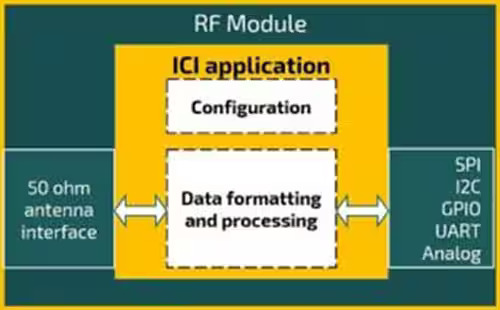
One key advantage of Radiocrafts Industrial IP Mesh solution (RIIM) is its support for 2-way symmetrical communication, which is crucial for valve control in smart irrigation systems. Unlike many other IoT connectivity solutions that focus on one-way sensor data communication, RIIM was designed to handle both up-link and down-link communication. This means that not only can RIIM collect sensor readings, but it can also effectively control devices such as valves, which require down-link communication. This makes RIIM a fully symmetric solution, enabling seamless communication in both directions.
This is especially important for smart irrigation systems, where valve control plays a critical role in managing water flow and optimizing irrigation schedules. Many popular LPWAN (Low Power Wide Area Networking) technologies struggle with scalable down-link communication, but RIIM is purpose-built to handle this requirement efficiently.
As a result, it can take many other LPWAN solutions around 1 minute or more to open and close a valve while RIIM can achieve this in just a couple of seconds. With RIIM, you can confidently manage both sensor data collection and device control, making it a comprehensive and reliable solution for smart irrigation applications.
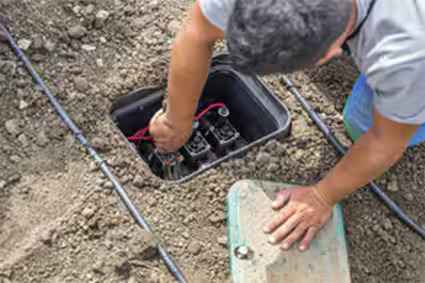
Furthermore, a fully symmetric communication approach enables Over-The-Air Updates (OTA) in RIIM. This means that you can update the user-defined ICI firmware even when the network is deployed and fully operational, allowing for seamless integration of new sensors or controllers as needed.
This is especially valuable in smart irrigation systems, where many locations may be hard to access and in operation for extended periods of time. OTA firmware updates ensure that your system stays up-to-date without disrupting its operation, providing a convenient and efficient way to add new functionalities or improve performance.
Radiocrafts Industrial IP Mesh solution (RIIM) is also renowned for its exceptional reliability, thanks to its support for Time Synchronized Channel Hopping (TSCH). TSCH is a mesh networking technique designed to minimize packet collisions and increase overall network reliability. In fact, TSCH-based networks have been proven to achieve reliability levels of up to 99.99%, making RIIM a robust and dependable solution for smart irrigation applications.
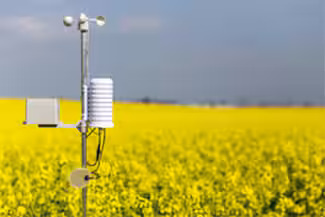
In addition, RIIM prioritizes security. It features encryption using a pre-shared key and supports DTLS end-to-end security, ensuring that your smart irrigation system remains protected from potential hackers. With RIIM, you can trust that your system data is secure, and your irrigation processes are safeguarded, providing peace of mind and confidence in the integrity of your smart irrigation system.
RIIM is specifically designed to operate on low power, making it ideal for long-lasting projects that rely on battery operation. For example, RIIM supports a battery lifetime of 7 years on just 2 AA batteries. How? By incorporating various features that work together to minimize power consumption, including:
- Low-power electronic components: RIIM utilizes energy-efficient electronic components, ensuring that the overall power consumption is minimized from the outset.
- “Sleepy” mode for network leaf nodes: RIIM allows network leaf nodes to be put in a low-power “Sleepy” mode, reducing their current consumption to a minimum of just 4.7 uA, which helps extend battery life.
- Configurable output power: The module’s output power can be adjusted, preventing unnecessary power consumption during transmit operations, and ensuring that only the required power is utilized.
- Time Synchronized Channel Hopping (TSCH): RIIM employs TSCH, which allows the mesh routers to go to sleep when there are no time slots for incoming or outgoing RF data packets, further conserving power.
- Data processing with ICI: RIIM supports data processing through the user-defined ICI firmware, which can significantly reduce power consumption. This allows for cloud computing, where only relevant data, such as alarms triggered by threshold crossings, is sent to the cloud, minimizing unnecessary data transfer and conserving power.
This impressive battery life makes Radiocrafts Industrial IP Mesh (RIIM) an excellent choice for projects that require long-term, low-power operation without frequent battery replacements.
What to Take Away From This?
As the global population continues to grow at an unprecedented rate, our finite resources, particularly our natural water sources, are becoming increasingly scarce. This pressing reality underscores the urgent need to use our limited resources as efficiently as possible. The Internet of Things (IoT), despite being a relatively new concept, has made remarkable strides in achieving this goal.
One area where the IoT industry has significantly contributed to maximizing efficiency while being eco-friendly is in the realm of Smart Irrigation. Creating an effective smart irrigation system requires meeting various requirements, such as long-range RF modules, extensive coverage, 2-way communication, and low power consumption, among others. Radiocrafts Industrial IP Mesh solution excels in meeting all these requirements and more, making it an ideal solution for Smart Irrigation. By leveraging the power of IoT, we can make significant strides towards sustainable water usage and conservation, contributing to a more eco-friendly and efficient future.
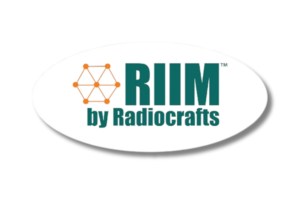 About this author
About this author
Radiocrafts designs, produces and markets high performance, high quality, and cost-effective standard RF modules for use in a variety of wireless short-range applications. The ease of use of these modules will help the user to increase their market success driven by short development time and fast production ramp-up while reducing investments and risk.
The article has been sourced from www.DigiKey.in



